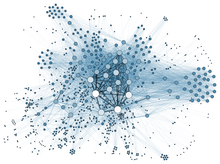Digital history
Digital history is the use of digital media to further historical analysis, presentation, and research. It is a branch of the digital humanities and an extension of quantitative history, cliometrics, and computing. Digital history is commonly digital public history, concerned primarily with engaging online audiences with historical content, or, digital research methods, that further academic research. Digital history outputs include: digital archives, online presentations, data visualizations, interactive maps, time-lines, audio files, and virtual worlds to make history more accessible to the user. Recent digital history projects focus on creativity, collaboration, and technical innovation, text mining, corpus linguistics, network analysis, 3D modeling, and big data analysis. By utilizing these resources, the user can rapidly develop new analyses that can link to, extend, and bring to life existing histories
Rooted in earlier social science history work, particularly around the history of enslavement in the United States, early digital history in the 1960s and 70s focused on using computers to conduct quantitative analyses, primarily of demographic and social history data - censuses, election returns, city directories, and other tabular or countable data. - with the aim of producing defensible research findings[1] These early computers could be programmed to conduct statistical analyses of these records, creating tallies, or seeking trends across records.[2] This research into historical demography was rooted in the rise of social history as a field of historical interest. The historians involved in this work sought to quantify past societies, to come to new conclusions about communities and population. Computers proved capable tools for that type of work. By the late 1970s younger historians turned to cultural studies, but the outpouring of quantitive studies by established scholars continued. Since then, quantitative history and cliometrics have been used primarily by historically-minded economists and political scientists. In the late 1980s quantifiers founded the Association for History and Computing. This movement provided some of the impetus for the rise of digital history in the 1990s.[3]
The more recent roots of digital history were in software rather than online networks. In 1982, the Library of Congress embarked on its Optical Disk Pilot Project, which placed text and images from its collection on to laserdiscs and CD-ROMs. The library started offering online exhibits in 1992 when it launched Selected Civil War Photographs. In 1993, Roy Rosenzweig, along with Steve Brier and Josh Brown, produced their award-winning CD-ROM Who Built America? From the Centennial Exposition of 1876 to the Great War of 1914, designed for Apple, Inc. that integrated images, text, film and sound clips, displayed in a visual interface that supported a text narrative.[4]
